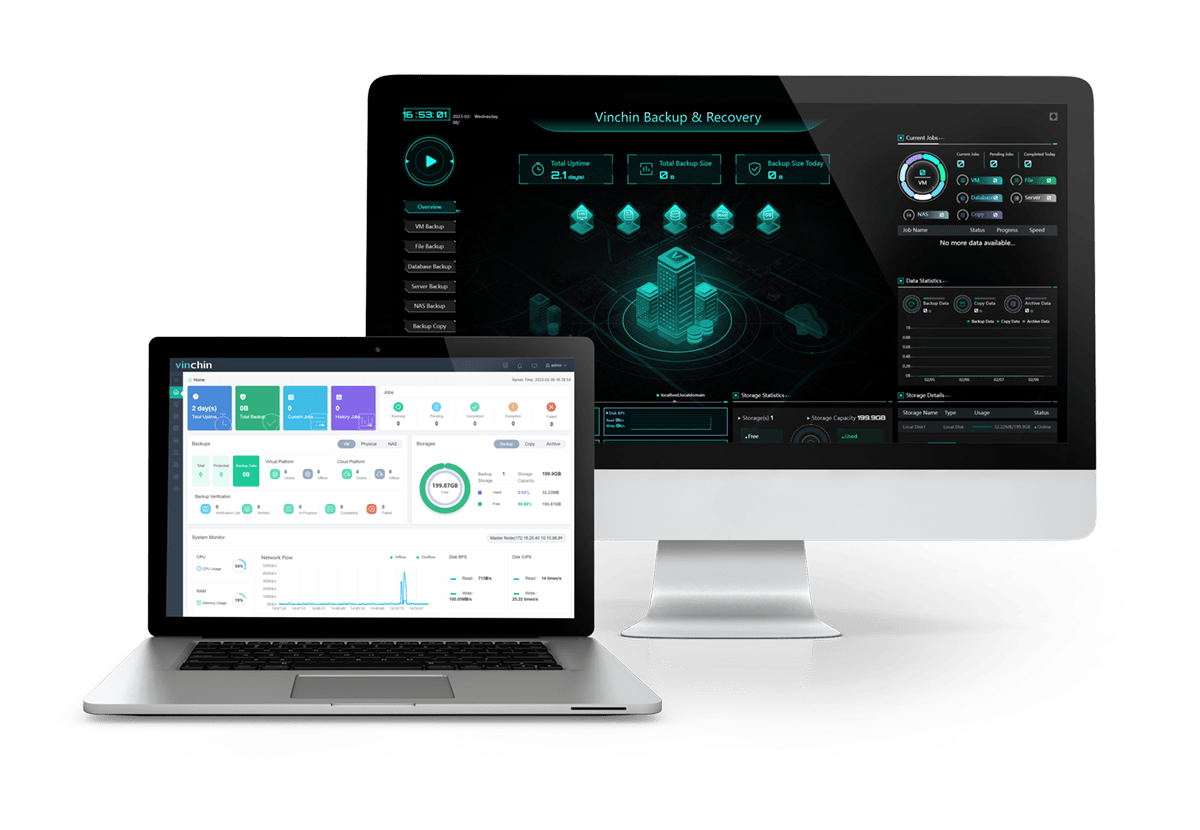-
What is data protection?
-
Why is data protection so important?
-
Data privacy
-
How to protect your data with backup?
-
How to guarantee business continuity with disaster recovery?
-
The differences between backup and disaster recovery
-
Principle of data protection
-
Protecting your data with Vinchin Backup & Recovery
-
Sum up
In the era of cloud computing and big data, the massive growth in data volume presents new challenges for data storage and protection. The technological advancements, represented by cloud architecture, virtualization, and hyper-convergence, have brought about iterative upgrades, accelerating the means of data protection.
This post will introduce some basic concepts of data protection and show you how ot keep business data safe and guarantee business continuity.
What is data protection?
Data protection is the practice of employing appropriate technical and organizational measures to prevent unauthorized access, alteration, disclosure, or destruction of data by authorized third parties or individuals with the capability to do so, thereby safeguarding data security.
Data protection encompasses two aspects: logical protection and physical protection. Logical protection includes database security, software security, network security, endpoint security and more. Physical protection includes encrypted transmission, electronic signatures, CCTV surveillance, and so on.
Data protection also includes business and legal requirements, such as privacy regulations. In terms of data security, both national and local governments have their own laws and regulations to regulate how businesses handle data related to personal information, implement privacy-based data protection mechanisms, and restrict violations.
Why is data protection so important?
Data is an essential asset for businesses, and the loss of critical data can deal a fatal blow to an enterprise. For example, in the aftermath of the 9/11 attacks, Bank of New York was forced into bankruptcy and liquidation due to data loss.
Why are the consequences so severe? It's because data is the reason and foundation for the existence of computer systems, which is often irreplaceable. Once data loss occurs, businesses can find themselves in a predicament, with customer information, technical files, financial records, and other crucial data related to customers, transactions, and production being destroyed beyond recognition.
For the financial institutions like banks, it is necessary to comply regulations of data retention requirements which will be good for both the banks and customers.
In summary, data loss can occur at three levels. First, there are logical errors, including software bugs, virus attacks, and data corruption. Second, there is physical damage, such as server and disk failures. Third, there are natural disasters that can devastate data centers.
The risks associated with data loss are constantly present. Incidents such as "deleting database deliberately, vulnerability backdoors, inherent system vulnerabilities, cloud service provider failures, misconfiguration errors, and data center fires" serve as painful lessons in the realm of data loss.
Data privacy
Data privacy, also called information privacy, is an aspect of data protection that addresses the proper storage, access, retention, immutability and security of sensitive data.
Data privacy is a subset of the broader data protection concept. It includes traditional data protection -- such as data backups and disaster recovery considerations -- and data security. The goal of data protection is to ensure the continued privacy and security of sensitive business data, while maintaining the availability, consistency and immutability of that data.
Data privacy is typically associated with the proper handling of personal data or personally identifiable information (PII), such as names, addresses, Social Security numbers and credit card numbers. However, the idea also extends to other valuable or confidential data, including financial data, intellectual property and personal health information. Vertical industry guidelines often govern data privacy and data protection initiatives, as well as regulatory requirements of various governing bodies and jurisdictions.
Data privacy is not a single concept or approach. Instead, it's a discipline involving rules, practices, guidelines and tools to help organizations establish and maintain required levels of privacy compliance.
How to protect your data with backup?
Whether it's a business or an individual, you can perform data backups. Backup is a copy of a predefined collection of data, and it is the fundamental method of data protection. It reflects the static state of a data collection at a specific moment. Backup files serve as the cornerstone of all data protection architectures, and the purpose of backup is to facilitate recovery.
In terms of backup architecture evolution, there are four types: local backup, network backup, LAN-Free (SAN) backup, and Server-Free backup.
Local backup: It has the advantages of fast backup speed and simple structure. However, it is not suitable for multi-host environments, which need complex management.
Network backup: It offers centralized backup and management, making full use of tape library resources. However, it consumes network resources, and network bottlenecks become apparent when dealing with large data backups.
LAN-Free (SAN) backup: It provides fast backup speed and eliminates backup bottlenecks caused by traditional networks. It is suitable for high-speed backups of large data volumes but tends to be more expensive.
Server-Free backup: It has the advantage of not causing additional cost on production servers, ensuring no performance degradation in the production system. However, it requires specialized equipment.
In terms of the evolution of backup technologies, it follows a path of scheduled backup - snapshot backup - real-time backup.
Scheduled backup: It has the advantage of wide software and hardware support, suitable for long-term storage. However, they require opening files for backup, which can lead to inconsistency issues when files within folders change. Additionally, they require dedicated backup time windows, resulting in a long Recovery Point Objective (RPO).
Snapshot backup: It is designed to address the issues of file changes during backup. However, snapshot backup may have compatibility issues and have significantly impact on the performance of production systems. Additionally, it also results in a larger RPO.
Real-time replication (such as CDP): It is developed to overcome the issues of file changes during backup and limited compatibility of snapshots. It allows recovery at any point in time, achieving an RPO≈zero.
How to guarantee business continuity with disaster recovery?
For enterprises and organizations, backup is often combined with disaster recovery. Backup protects data, while disaster recovery ensures business continuity based on the backup. From this perspective, disaster recovery is generally divided into data disaster recovery and application disaster recovery.
Data disaster recovery refers to establishing a remote data system that provides real-time replication of critical application data from the local site.
Application disaster recovery refers to establishing a complete backup application system at a remote location based on data disaster recovery. In the event of a disaster, the backup system quickly takes over the business operations.
When considering backup and disaster recovery, two concepts need to be emphasized:
Recovery Point Objective (RPO) is the point in time to which the disaster recovery system can restore data after a disaster occurs. It measures the amount of data that an enterprise can afford to lose. RPO can be described as the maximum acceptable data loss for the organization.
Recovery Time Objective (RTO) is the time interval from the moment the system goes down and business operations are interrupted to the moment the system is restored and can support the business departments to resume operations. RTO can be described as the acceptable recovery time for the organization.
The differences between backup and disaster recovery
Backup and disaster recovery are indeed separate concepts. Backup is the process of protecting data, while disaster recovery is focused on ensuring business continuity. With the emergence of integrated disaster recovery solutions, these two concepts are often included together, which can lead to confusion when users are purchasing software products, so that the manufacturer may not ensure whether users need backup products or disaster recovery products or expect a combination of both.
Disaster recovery is the ultimate goal, while backup is just one of the means to achieve it and not the only one. Backup involves creating copies of data and storing them on different media, providing a means of recovery in case of data loss. However, having backups alone does not guarantee disaster recovery. Backup is a part of the broader concept of disaster recovery, which involves deploying various technical measures to ensure business continuity.
In a disaster recovery scenario, the purpose is to ensure that business operations do not get interrupted or can be automatically restored after an unexpected event. This requires deploying technical measures to protect each component, such as servers, networks, and storage systems. Backup is just one aspect of disaster recovery, and the focus of disaster recovery is on achieving uninterrupted business operations.
In summary, backup and disaster recovery are distinct concepts. Backup is a method of data protection, while disaster recovery is the broader objective of ensuring business continuity. Backup is one of the means to achieve disaster recovery, but additional measures are required for comprehensive disaster recovery capabilities.
Principle of data protection
The data protection principles are a set of fundamental guidelines that outline how personal data should be processed and protected. These principles are often incorporated into data protection laws and regulations. While specific principles may vary slightly depending on the jurisdiction, the following are commonly recognized data protection principles according to GDPR:
Lawfulness, Fairness, and Transparency
Purpose Limitation
Data Minimization
Accuracy
Storage Limitation
Integrity and Confidentiality
Accountability
Protecting your data with Vinchin Backup & Recovery
For reliable data protection , you can rely on Vinchin Backup & Recovery, which has help many enterprises and organizations protect their data.

Vinchin Backup & Recovery is a professional solution which supports data backup of VM like VMware vSphere, Hyper-V, XenServer, XCP-ng, oVirt, RHV, OpenStack, etc. and other data like database, NAS, file server, etc.
Data can be directly transferred between production storage and backup storage via LAN-Free path (FC, iSCSI, NFS storage area network) without affecting production network load.
In addition, Vinchin Backup & Recovery offers a set of cutting-edge features to automate, expedite, and renovate the protection of virtual machines and databases to help you better face the challenges carried out by foxy data security threats that are possible to have you violating GDPR without signs.
Vinchin Backup & Recovery has been select by thousands of companies and organizations and you can also start to use this powerful system with a 60-day full-featured free trial. Just click the button to get the installation package.
Sum up
With the rapid development of network and computer technology, data leakage and data security issues are becoming more and more serious. Therefore, protecting data security and privacy has become a problem that enterprises and individuals must face.
Vinchin Backup & Recovery is a good solution to protect your data in various environment.
Share on:








